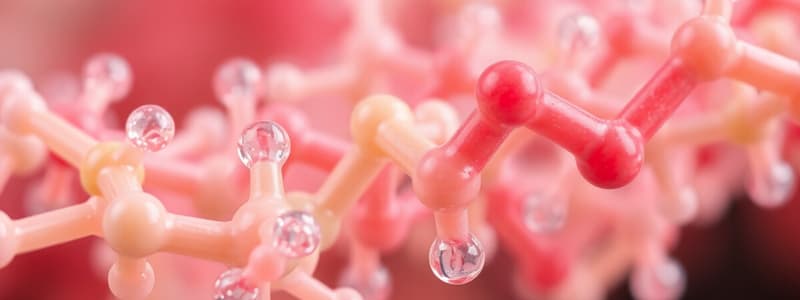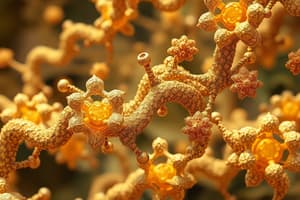Podcast
Questions and Answers
What is the main function of an enzyme in the body?
What is the main function of an enzyme in the body?
- To store energy
- To provide structural support
- To act as a genetic material
- To speed up chemical reactions (correct)
What is the relationship between a substrate and an enzyme?
What is the relationship between a substrate and an enzyme?
- Substrates change the shape of the enzyme
- Enzymes can bind with multiple substrates at once
- Enzymes and substrates do not interact
- Substrates fit into the active site of enzymes (correct)
In the enzyme action process, what forms after the substrate binds to the enzyme?
In the enzyme action process, what forms after the substrate binds to the enzyme?
- Cofactor
- Enzyme-substrate complex (correct)
- Product
- Active site
Which model suggests that the shape of the enzyme and substrate are rigid and fixed?
Which model suggests that the shape of the enzyme and substrate are rigid and fixed?
What occurs during the Induced Fit Model of enzyme action?
What occurs during the Induced Fit Model of enzyme action?
What are coenzymes classified as?
What are coenzymes classified as?
What is the process called when products are released after an enzyme-substrate interaction?
What is the process called when products are released after an enzyme-substrate interaction?
What happens to the enzyme after the reaction takes place?
What happens to the enzyme after the reaction takes place?
How do strong reaction rates typically proceed in the absence of an enzyme?
How do strong reaction rates typically proceed in the absence of an enzyme?
Which of the following statements about enzyme specificity is correct?
Which of the following statements about enzyme specificity is correct?
What suffix is commonly added to the name of enzymes to indicate their function?
What suffix is commonly added to the name of enzymes to indicate their function?
In the EC nomenclature system, what does the first digit represent?
In the EC nomenclature system, what does the first digit represent?
Which enzyme is responsible for breaking down lactose?
Which enzyme is responsible for breaking down lactose?
Which of the following factors does NOT influence enzyme action?
Which of the following factors does NOT influence enzyme action?
What is the EC number for an enzyme acting on the CH-OH group of donors with NADP+ as an acceptor?
What is the EC number for an enzyme acting on the CH-OH group of donors with NADP+ as an acceptor?
Which enzyme is responsible for the breakdown of fibers?
Which enzyme is responsible for the breakdown of fibers?
If an enzyme's activity decreases due to the presence of a substance, what is that substance called?
If an enzyme's activity decreases due to the presence of a substance, what is that substance called?
Which of the following is an example of a coloring enzyme?
Which of the following is an example of a coloring enzyme?
Which enzyme catalyzes the breakdown of starch?
Which enzyme catalyzes the breakdown of starch?
What is a common method of encoding enzyme functions in the EC system?
What is a common method of encoding enzyme functions in the EC system?
Flashcards are hidden until you start studying
Study Notes
Importance and Definition of Enzymes
- Enzymes are complex organic compounds crucial for speeding up chemical reactions in the body without being consumed.
- They exhibit high specificity, catalyzing only one specific reaction and can be recycled.
Structure of Enzymes
- Enzymes interact with substrates at an active site, forming an enzyme-substrate complex.
- The substrate can either break down or combine to create products.
Mode of Enzyme Action
- Substrate contacts the enzyme's active site, leading to the formation of an enzyme-substrate complex.
- After transformation, products are formed and released, allowing the unchanged enzyme to catalyze further reactions.
Enzyme Models
- Lock and Key Model: Proposed by Emil Fischer (1894), suggests that the enzyme and substrate fit together like a key in a lock.
- Induced Fit Model: Proposed by Daniel E. Koshland Jr. (1958), indicates the substrate induces a conformational change in the enzyme, enhancing binding.
Cofactors and Coenzymes
- Cofactors can be organic or inorganic and aid in substrate recruitment; they may bind loosely to enzymes.
- Coenzymes are organic molecules that assist enzymes in their functions.
Nomenclature of Enzymes
- Enzymes are named by adding the suffix -ase to the substrate (e.g., lactase for lactose) or to the reaction catalyst (e.g., oxidase).
- A systematic nomenclature includes an EC (enzyme class) number, with four digits representing class, subclass, sub-subclass, and specific enzyme number.
Examples of Biological Enzymes
- Lipase: Breaks down fats.
- Protease: Breaks down proteins.
- Cellulase: Breaks down cellulose (fiber).
- Amylase: Breaks down starch.
- Sucrase: Breaks down sucrose.
- Maltase: Breaks down maltose.
- Lactase: Breaks down lactose.
Factors Influencing Enzyme Action
- Substrate concentration affects enzyme activity.
- Enzyme concentration, along with temperature and pH, also influences performance.
- Presence of accelerators can enhance, while inhibitors can hinder enzyme action.
- Environmental hazards can impact enzyme functionality.
Studying That Suits You
Use AI to generate personalized quizzes and flashcards to suit your learning preferences.




